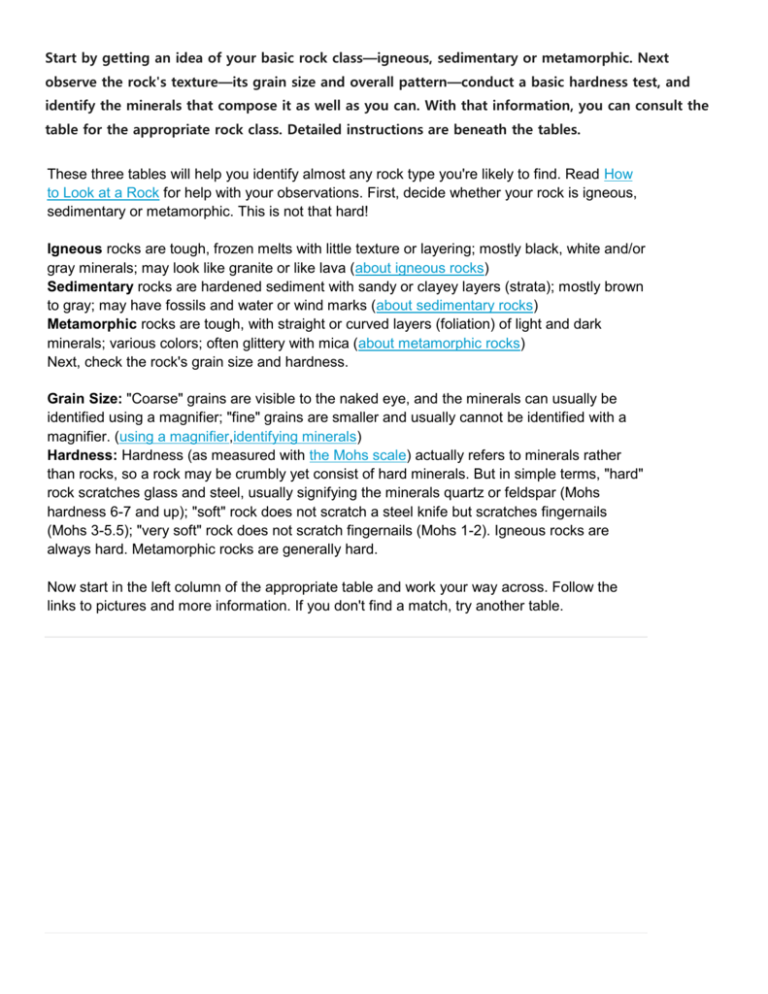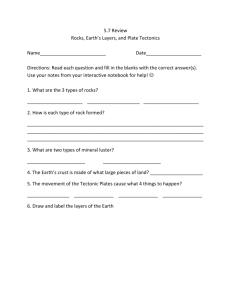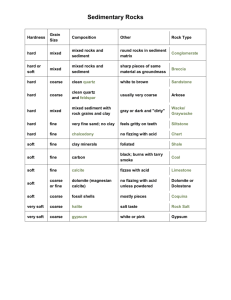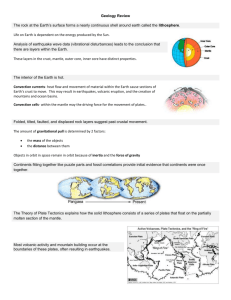Start by getting an idea of your basic rock class—igneous
advertisement

Start by getting an idea of your basic rock class—igneous, sedimentary or metamorphic. Next observe the rock's texture—its grain size and overall pattern—conduct a basic hardness test, and identify the minerals that compose it as well as you can. With that information, you can consult the table for the appropriate rock class. Detailed instructions are beneath the tables. These three tables will help you identify almost any rock type you're likely to find. Read How to Look at a Rock for help with your observations. First, decide whether your rock is igneous, sedimentary or metamorphic. This is not that hard! Igneous rocks are tough, frozen melts with little texture or layering; mostly black, white and/or gray minerals; may look like granite or like lava (about igneous rocks) Sedimentary rocks are hardened sediment with sandy or clayey layers (strata); mostly brown to gray; may have fossils and water or wind marks (about sedimentary rocks) Metamorphic rocks are tough, with straight or curved layers (foliation) of light and dark minerals; various colors; often glittery with mica (about metamorphic rocks) Next, check the rock's grain size and hardness. Grain Size: "Coarse" grains are visible to the naked eye, and the minerals can usually be identified using a magnifier; "fine" grains are smaller and usually cannot be identified with a magnifier. (using a magnifier,identifying minerals) Hardness: Hardness (as measured with the Mohs scale) actually refers to minerals rather than rocks, so a rock may be crumbly yet consist of hard minerals. But in simple terms, "hard" rock scratches glass and steel, usually signifying the minerals quartz or feldspar (Mohs hardness 6-7 and up); "soft" rock does not scratch a steel knife but scratches fingernails (Mohs 3-5.5); "very soft" rock does not scratch fingernails (Mohs 1-2). Igneous rocks are always hard. Metamorphic rocks are generally hard. Now start in the left column of the appropriate table and work your way across. Follow the links to pictures and more information. If you don't find a match, try another table. Identification of Igneous Rocks Grain Size Usual Color Other Composition Rock Type fine dark glassy appearance lava glass Obsidian fine light many small bubbles lava froth from sticky lava Pumice fine dark many large bubbles lava froth from fluid lava Scoria fine or mixed light contains quartz high-silica lava Felsite fine or mixed medium between felsite and basalt medium-silica lava Andesite fine or mixed dark has no quartz low-silica lava Basalt mixed any color large grains in finegrained matrix large grains of feldspar, quartz, pyroxene orolivine Porphyry coarse light wide range of color and feldspar and quartz with minor grain size mica, amphibole or pyroxene Granite coarse light like granite but without feldspar with minor mica, quartz amphibole or pyroxene Syenite coarse light to medium little or no alkali feldspar plagioclase and quartz with dark minerals Tonalite coarse medium to little or no quartz dark low-calcium plagioclase and dark minerals Diorite coarse medium to no quartz; may dark haveolivine high-calcium plagioclase and dark minerals Gabbro coarse dark dense; always has olivine olivine with amphibole and/or pyroxene Peridotite coarse dark dense mostly pyroxene with olivine and amphibole Pyroxenite coarse green dense at least 90% olivine Dunite very coarse any color usually in small intrusive bodies typically granitic Pegmatite Identification of Sedimentary Rocks Hardness Grain Size Composition Other Rock Type hard coarse clean quartz white to brown Sandstone hard coarse quartz and feldspar usually very coarse Arkose hard or soft mixed mixed sediment with rock grains and clay gray or dark and "dirty" Wacke/ Graywacke hard or soft mixed mixed rocks and sediment round rocks in finer sediment matrix Conglomerate hard or soft mixed mixed rocks and sediment sharp pieces in finer sediment matrix Breccia hard fine very fine sand; no clay feels gritty on teeth Siltstone hard fine chalcedony no fizzing with acid Chert soft fine clay minerals splits in layers Shale soft fine carbon black; burns with tarry smoke Coal soft fine calcite fizzes with acid Limestone soft coarse or dolomite fine no fizzing with acid unless powdered Dolomite rock soft coarse fossil shells mostly pieces Coquina very soft coarse halite salt taste Rock Salt very soft coarse gypsum white, tan or pink Rock Gypsum Identification of Metamorphic Rocks Foliation Grain Size Usual Color Other Rock Type foliated fine light very soft; greasy feel Soapstone foliated fine dark soft; strong cleavage Slate nonfoliated fine dark soft; massive structure Argillite foliated fine dark shiny; crinkly foliation Phyllite foliated coarse mixed dark and light crushed and stretched fabric; deformed large crystals Mylonite foliated coarse mixed dark and light wrinkled foliation; often has large crystals Schist foliated coarse mixed banded Gneiss foliated coarse mixed distorted "melted" layers Migmatite foliated coarse dark mostly hornblende Amphibolite nonfoliated fine greenish soft; shiny, mottled surface Serpentinite nonfoliated fine or coarse dark dull and opaque colors, found near intrusions Hornfels nonfoliated coarse red and green dense; garnet and pyroxene Eclogite nonfoliated coarse light soft; calcite or dolomite by the acid test Marble nonfoliated coarse light quartz (no fizzing with acid) Quartzite







